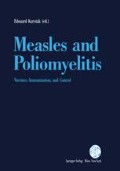Summary
Both inactivated and oral poliovirus vaccines have successfully eradicated poliomyelitis in the developed world. Inactivated vaccine may appear to have some advantages for the developing world, particularly with regard to interference and greater stability, but fails to address the major reservoir of faecal-orally spread virus, the gastrointestinal tract. Inactivated vaccine used to supplement oral vaccine schedules increases cost and could cause confusion in adminis tration. Interference in oral vaccine schedules could be addressed by a supplementary neonatal dose. In most of Africa, type 1 poliovirus is the dominant endemic strain and also the cause of outbreaks, and neonatal supplementation with type 1 would have particular advantages.
Access this chapter
Tax calculation will be finalised at checkout
Purchases are for personal use only
Preview
Unable to display preview. Download preview PDF.
References
Kok PW, Leeuwenburg J, Tukei P, van Wezel AL, Kapsenberg JG, van Steenis G, Galazka A, Robertson SE, Robinson D (1992) Serological and virological assessment of oral and inactivated poliovirus vaccines in a rural population in Kenya. Bull WHO 70:93–103
Johnson S, Schoub BD, McAnerney JM, Gear JSS, Moodie JM, Garrity SL, Klaassen KIM ,Küstner HGV (1984) Poliomyelitis outbreak in South Africa ,1982. II. Laboratory and vaccine aspects. Trans R Soc Trop Med Hyg 78: 26–31
Schoub BD, Johnson S, McAnerney JM, Küstner HGV, van der Merwe GA (1986) A comprehensive investigation of immunity to poliomyelitis in a developing country. Am J Epidemiol 123: 316–324
Schoub BD, Johnson S, McAnerney JM, van Middelkoop A, Küstner HGV, Windsor I, Vinsen C, McDonald K (1992) Poliomyelitis outbreak in Natal/KwaZulu, South Africa, 1987–1988. 2. Immunity aspects. Trans R Soc Trop Med Hyg 86:83–85
Kim-Farley RJ, Rutherford G, Lichfield P, Hsu S-T, Orenstein WA, Schonberger LB, Bart KJ, Lui K-J, Lin C-C (1984) Outbreak of paralytic poliomyelitis, Taiwan. Lancet ii: 1322–1324
World Health Organizaiton (1989) Expanded Programme on Immunization (EPI). Poliomyelitis in 1986,1987 and 1988, Part I. Wkly Epidem Rec 64: 273–279
Sutter RW, Patriarca PA, Brogan S, Malankar PG, Pallansch MA, Kew OM, Bass AG, Cochi SL, Alexander JP, Hall DB, Suleiman AJM, Al-Ghassany AAK, El-Bualy MS (1991) Outbreak of paralytic poliomyelitis in Oman: evidence for widespread transmission among fully vaccinated children. Lancet 338: 715–720
van Middelkoop A, van Wyk JE, Küstner HGV, Windsor I, Vinsen C, Schoub BD, Johnson S, McAnerney JM (1992) Poliomyelitis outbreak in Natal/KwaZulu, South Africa, 1987–1988. I. Epidemiology. Trans R Soc Trop Med Hyg 86:80–82
Hovi T (1989) The outbreak of poliomyelitis in Finland in 1984–1985. Significance of antigenic variation of type 3 polioviruses and site-specificity of antibody responses in antipolio immunization. Adv Virus Res 37: 243–275
World Health Organization (1984) Poliomyelitis outbreak in Israel. Wkly Epidem Rec 63:325–326
Onorato IM, Modlin JF, McBean AM, Thoms ML, Losonsky GA, Bernier RH (1991) Mucosal immunity induced by enhanced-potency inactivated and oral polio vaccines. J Infect Dis 163: 1–6
Department of National Health, South Africa (1990) The six vaccine-preventable diseases. Epidem Comments 17: 3–19
Tulchinsky T, Abed Y, Shaheen S, Toubassi N, Sever Y, Schoenbaum M, Handsher R (1989) A ten-year experience in control of poliomyelitis through a combination of live and killed vaccines in two developing areas. Am J Public Health 79: 1648–1652
World Health Organization Expanded Programme on Immunization (1985) Global advisory group. Wkly Epidem Rec 60: 13–16
Schoub BD, Johnson S, McAnerney J, Gilbertson L, Klaassen KIM, Reinach SG (1988) Monovalent neonatal polio immunization -a strategy for the developing world. J Infect Dis 157: 836–839
Author information
Authors and Affiliations
Editor information
Editors and Affiliations
Rights and permissions
Copyright information
© 1993 Springer-Verlag/Wien
About this chapter
Cite this chapter
Schoub, B.D. (1993). Immunogenicity of poliovirus vaccines with special reference to the choice between oral and inactivated vaccines in developing countries. In: Kurstak, E. (eds) Measles and Poliomyelitis. Springer, Vienna. https://doi.org/10.1007/978-3-7091-9278-8_24
Download citation
DOI: https://doi.org/10.1007/978-3-7091-9278-8_24
Publisher Name: Springer, Vienna
Print ISBN: 978-3-211-82436-8
Online ISBN: 978-3-7091-9278-8
eBook Packages: Springer Book Archive

